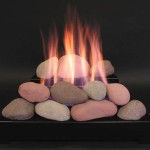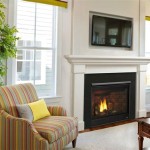Veneer Stone Fireplace: A Comprehensive Guide
A veneer stone fireplace offers a captivating blend of aesthetic appeal and practical functionality, making it a popular choice for homeowners seeking to enhance the warmth and ambiance of their living spaces. Unlike full-stone fireplaces, which require substantial structural support and are significantly more expensive, veneer stone provides the visual impact of real stone without the associated weight and cost implications. This article provides an in-depth exploration of veneer stone fireplaces, covering their types, installation, design considerations, maintenance, and key advantages.
Understanding Veneer Stone
Veneer stone, also referred to as manufactured stone or faux stone, is a lightweight facing material designed to replicate the appearance of natural stone. It is typically composed of a mixture of Portland cement, aggregates, and pigments, molded into shapes and textures that mimic various natural stone types, such as fieldstone, ledgestone, river rock, and brick. The manufacturing process allows for consistent color and texture, which can be difficult to achieve with natural stone. Veneer stone is available in a wide range of colors, sizes, and styles, offering homeowners numerous design options to complement their interior decor.
The key advantage of veneer stone lies in its significantly reduced weight compared to natural stone. This characteristic eliminates the need for reinforced foundations and structural modifications often required for full-stone installations. Additionally, veneer stone is typically easier and faster to install, leading to lower labor costs. Its consistent composition and predictable performance also contribute to its popularity among builders and homeowners.
Types of Veneer Stone for Fireplaces
Choosing the right type of veneer stone for a fireplace depends on the desired aesthetic, the architectural style of the home, and the budget. Two primary categories of veneer stone exist: manufactured stone and natural stone veneer.
Manufactured Stone Veneer: This type is produced from a mold, using a mixture of cement, aggregates, and pigments. It offers the greatest variety in terms of style, color, and texture. Manufactured stone is generally less expensive than natural stone veneer and easier to install due to its consistent size and shape. It is also lightweight, reducing the need for extensive structural support. However, it is important to select a high-quality manufactured stone to ensure durability and resistance to fading or cracking.
Natural Stone Veneer: This consists of thin slices of real stone that are adhered to a backing material. While more expensive than manufactured stone, natural stone veneer offers the authentic look and feel of real stone. It is available in a variety of natural stone types, each with its unique color variations and textures. Natural stone veneer can add a touch of luxury and character to a fireplace. However, it is heavier than manufactured stone and may require more specialized installation techniques.
Within these two categories, specific styles of veneer stone are commonly used for fireplaces, including:
* Ledgestone: Characterized by its long, thin, and stacked appearance, ledgestone adds a rustic and textured look to a fireplace. It is often used to create a contemporary or transitional style. * Fieldstone: Replicating the look of natural fieldstones gathered from fields, this style features irregular shapes and sizes, providing a natural and organic feel. * River Rock: Mimicking the smooth, rounded stones found in riverbeds, river rock veneer adds a touch of warmth and tranquility to a fireplace. * Brick Veneer: Offering the classic look of brick, brick veneer is a versatile choice that complements a wide range of architectural styles.Installation Considerations for Veneer Stone Fireplaces
Proper installation is crucial for ensuring the longevity and aesthetic appeal of a veneer stone fireplace. Whether opting for a do-it-yourself approach or professional installation, several key considerations must be addressed.
Surface Preparation: The surface onto which the veneer stone will be applied must be clean, dry, and structurally sound. Typically, a layer of cement board or metal lath is installed over the existing fireplace surround to provide a suitable substrate for the mortar. Ensuring the surface is level and plumb is essential for a professional-looking finish.
Mortar Application: A high-quality mortar specifically designed for veneer stone applications should be used. The mortar should be mixed according to the manufacturer's instructions and applied evenly to the back of each stone and the prepared surface. Proper mortar adhesion is critical for preventing the veneer stone from detaching over time. Select a mortar color that complements the color of the stone.
Stone Placement: Carefully plan the layout of the veneer stone before beginning the installation process. Arrange the stones to create a visually appealing pattern, paying attention to color variations, sizes, and shapes. Use spacers to maintain consistent grout lines between the stones. Avoid creating obvious repeating patterns, which can detract from the natural look of the veneer stone. Consider using a level and plumb bob to ensure the stones are installed straight and even.
Cutting and Shaping: In many cases, it will be necessary to cut or shape the veneer stone to fit around corners, edges, or openings. A wet saw with a diamond blade is the most effective tool for cutting veneer stone. Always wear appropriate safety gear, including eye protection and a dust mask, when cutting stone. Care should be taken to create clean and precise cuts to ensure a professional finish.
Grouting: Once the veneer stone has been installed and the mortar has cured, the grout lines can be filled. Select a grout color that complements the color of the stone and apply it using a grout bag or trowel. After the grout has partially dried, use a damp sponge to clean the excess grout from the surface of the stone. Different grouting techniques, such as a flush grout or a recessed grout, can create different visual effects.
Design Elements and Styling a Veneer Stone Fireplace
The design possibilities for veneer stone fireplaces are virtually limitless, allowing homeowners to create a focal point that reflects their personal style and enhances the overall aesthetic of their living space. Several key design elements can be considered when planning a veneer stone fireplace.
Fireplace Surround: The fireplace surround encompasses the area around the firebox and provides the framework for the veneer stone installation. The size, shape, and style of the surround can significantly impact the overall look of the fireplace. Consider the proportions of the room and the existing architectural features when designing the surround. A larger surround can create a more dramatic statement, while a smaller surround can be more subtle and understated.
Mantel Design: A mantel adds a decorative element to the fireplace and provides a surface for displaying artwork, photos, or other decorative items. The mantel can be made from a variety of materials, such as wood, stone, or metal, and its style should complement the overall design of the fireplace. A rustic wooden mantel can enhance the natural look of a fieldstone veneer, while a sleek metal mantel can complement a contemporary ledgestone veneer.
Hearth Options: The hearth, the area in front of the firebox, provides a safety barrier and adds a visual element to the fireplace. The hearth can be made from a variety of materials, such as stone, tile, or brick, and its size and shape should be proportional to the fireplace surround. A raised hearth can create a more dramatic look, while a flush hearth can be more subtle and integrated.
Color Palette: The color of the veneer stone should complement the existing color palette of the room. Consider the color of the walls, flooring, and furniture when selecting the veneer stone. Neutral colors, such as grays, beiges, and browns, are versatile choices that can complement a wide range of decorating styles. Warmer colors, such as reds and oranges, can add a touch of warmth and vibrancy to the room. Cooler colors, such as blues and greens, can create a more calming and relaxing atmosphere.
Lighting: Proper lighting can enhance the texture and beauty of the veneer stone. Consider installing recessed lighting or spotlights to highlight the fireplace. A fireplace can also serve as a focal point for ambient lighting, with strategically placed lamps or candles creating a warm and inviting atmosphere.
Maintaining a Veneer Stone Fireplace
Regular maintenance is essential for preserving the appearance and longevity of a veneer stone fireplace. Simple cleaning procedures can help prevent the build-up of dirt, dust, and soot, ensuring that the fireplace remains a captivating focal point in the home.
Regular Cleaning: The veneer stone should be cleaned regularly with a soft brush or vacuum cleaner to remove dust and debris. A mild detergent solution can be used to clean stubborn stains. Avoid using harsh chemicals or abrasive cleaners, as they can damage the surface of the stone. Always test any cleaning solution on an inconspicuous area of the stone before applying it to the entire surface.
Mortar Joint Inspection: Periodically inspect the mortar joints for cracks, chips, or other signs of damage. Promptly repair any damaged mortar joints to prevent water from penetrating behind the veneer stone. A small amount of mortar can be mixed according to the manufacturer's instructions and applied to the damaged area using a trowel.
Sealing: Applying a sealant to the veneer stone can help protect it from staining and water damage. Choose a sealant specifically designed for veneer stone applications and apply it according to the manufacturer's instructions. Sealing can also enhance the color and texture of the stone.
Soot Removal: Soot buildup on the veneer stone can darken its appearance. Use a soot remover specifically designed for stone fireplaces to remove soot buildup. Follow the manufacturer's instructions carefully when using soot removers. Regular chimney cleaning can also help prevent soot buildup.
Advantages of Veneer Stone Fireplaces
Choosing a veneer stone fireplace offers several significant advantages over traditional full-stone fireplaces, making them a popular and practical choice for homeowners.
Cost-Effectiveness
Veneer stone is significantly less expensive than natural stone, both in terms of material costs and installation costs. The lightweight nature of veneer stone reduces the need for extensive structural support, further minimizing expenses. The cost savings associated with veneer stone make it an attractive option for homeowners on a budget.
Ease of Installation
Veneer stone is easier and faster to install than natural stone, requiring less specialized skills and equipment. This can translate into lower labor costs and a quicker project completion time. Homeowners with basic DIY skills may even be able to install veneer stone themselves, further reducing expenses.
Design Versatility
Veneer stone is available in a wide range of colors, styles, and textures, offering homeowners virtually limitless design possibilities. Whether seeking a rustic, contemporary, or traditional look, veneer stone can be customized to complement any architectural style and personal preference. The consistent color and texture of manufactured stone make it easier to create a uniform and aesthetically pleasing fireplace.

11 Stone Veneer Fireplace Surround Design Trends Where To Buy

Stone Veneer Fireplace Ideas That Will Warm Up Your Home Ply Gem

Thin Stone Veneers Make A Fireplace Update Easy

The Benefits Of Thin Stone Veneer For Your Fireplace

Thincut Natural Stone Veneer Csi All Things Can En

Weathered Stone Veneer Natural Thin Cape Cod Nantucket Ma

Natural Stacked Stone Veneer Fireplace Ideas

Thin Stone Veneers Make A Fireplace Update Easy

Stone Veneer Interior Design Living Room Kitchen Bedroom Ideas More Buechel

Stone Veneer Fireplaces Natural Facing








